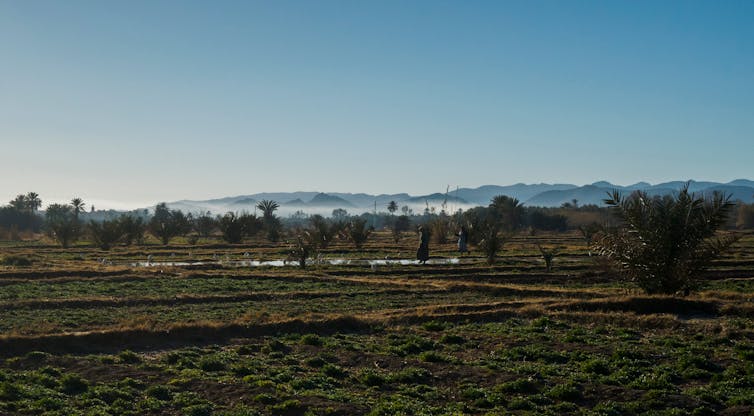
Trees do a lot more for us than you probably think. Their roots prevent soil from eroding, their canopies provide shade and their leaves decompose into nutrients for crops, which feed livestock. Trees provide homes for a diverse range of wildlife and tree crops, such as coffee, rubber, and hardwoods, support countless livelihoods and entire economies. Trees also mark boundaries and hold immense spiritual, cultural and social value for smallholder communities around the world.
In the 1980s, charities proposed planting more trees to halt “desertification” in the Sahara Desert. This involved “afforestation” – planting trees where they had not grown for a while and “reforestation” – replacing recently lost tree cover.
Today the idea is growing strong, and an array of private companies from adult website Pornhub (yes, Pornhub) to clothing brand Ten Tree are using trees as a marketing tool.
Read more: Pornhub has planted a few more trees, but don't pretend it's being responsible
Saving face or saving forests?
Businesses can offset their environmental impact by planting trees or supporting other forms of habitat restoration, so as to “pay off” the damage they cause locally. As climate change escalates, trees are in vogue for their potential to soak up the carbon dioxide we keep putting in the atmosphere.
The United Nations (UN) has even adopted a scheme for offering local communities and governments some sort of financial payout for saving trees from deforestation. This “economy of repair” has been adopted by some of the largest companies in their commitments to corporate social responsibility. One such programme is the Green Belt Movement – a Kenyan conservation NGO started by the late professor and Nobel Prize recipient Wangari Maathai.

Maathai’s original mission was to empower local people, particularly women, to overcome inequality through leading forest restoration and resisting the expanding Sahara Desert. Despite the involvement of charities and businesses, research has suggested that in programmes like these, it is farmers and local people, not companies, which make the biggest contributions to planting new trees. Since local people also inherit responsibility for them, it’s important that projects devised by outside parties are planned and executed wisely, and in the community’s interest.
Read more: Africa's got plans for a Great Green Wall: why the idea needs a rethink
While some may argue that tree planting is a win-win for the environment whoever does it, offsetting is just another way of corporate greenwashing. Environmental damage in one place cannot somehow be fixed by repairing habitats elsewhere, sometimes on the other side of the world.
Here are some of the ways in which indiscriminate tree planting can cause more harm than good.
Plantations are not forests
Diverse forests are often cleared for agricultural production or industrial use, and replaced by uniform stands of the same species selected because of their ability to grow fast.
Tropical forests in some cases take up to 65 years to regrow and their diversity cannot be replicated by a monoculture of reforested plots.
Ecologically illiterate
Reforestation and afforestation schemes must decide which species are appropriate to plant – native or exotic, multi-purpose or fast growing, naturally regenerating forests or managed plantations. Sometimes the wrong species are selected and Eucalyptus (Eucalyptus globulus) is one such poor choice.
Eucalyptus is usually chosen because it is fast growing and economically valuable. Yet, it is exotic to many places it is now planted and requires lots of water, which drains the water table and competes with native crops.
In Europe, replacing broad-leafed native oak trees with faster growing conifers has meant that forest cover on the continent is 10% greater than it was before the industrial revolution. However, the new trees are not as good at trapping carbon but do trap heat more efficiently, contributing to global warming. Clearly, tree planting without due caution can do more harm than good.
Trees need care – lots of it
Tree species take a long time to grow and need continual care. However, tree planting schemes usually “plant and go” –- meaning they do not put resources into managing the trees after they are placed into the ground. Young trees are particularly vulnerable to disease and competition for light and nutrients and if not cared for, will eventually die.

Trees are political
Trees planted by states or private donors may choose sites without consulting local communities, ignoring any of their customary land rights and management regimes. This locally-owned land may be in fallow or have different economic, cultural or spiritual uses.
Blundering into planting in these places may exacerbate tensions over land tenure, spreading disinterest in tree care and stewardship. Dispossessed locals may move to existing forests and clear land for food production. Tenure rights over trees are also not always owned by whole households either, but divided between gender. Planting trees and asking questions later may sow tensions over land ownership for long after the project departs.
It’s no surprise that trees are on the green economy agenda, but this does not necessarily mean that planting them is “green” or helpful for social harmony. Allowing trees to regrow naturally is not always effective either, as trees are unlikely to survive on their own. Community involvement is therefore crucial.
This means real consultation over site and species selection, property rights over the trees, their products, and the land they grow in and who takes on the labour to keep the trees alive after they are planted. If companies are serious about planting trees then they need to care about the communities that live with them and not just their own reputations.
Benjamin Neimark, Senior Lecturer, Lancaster Environment Centre, Lancaster University
This article is republished from The Conversation under a Creative Commons license. Read the original article.

